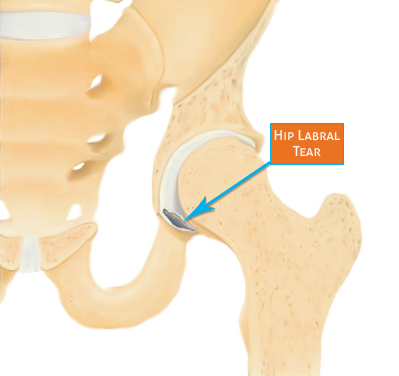What is a Hip Labral Tear?

The hip labral tear is the most common of the labral tears. To describe this injury, the hip mimics the shape of a ball and socket. The ball is the femoral head, and the socket is the acetabulum. The labrum helps the femoral head to move effortlessly within the socket. Thus allowing the hip to move without difficulty. Plus, it also provides stability and acts as a shock absorber.
A hip labral tear occurs when the labrum is injured and separated from the socket. This type of injury is typical in those who participate in athletics. These sports include the following:
- Ice hockey
- Soccer
- Football
- Golf
- Ballet
Symptoms of a Hip Labral Tear:
Most people with this condition don’t experience symptoms immediately. However, when symptoms so show, they will include:
- Painful clicking during hip movements
- A deep ache in front of the groin or hip
- Pain that increases with prolonged walking or sitting
- Stiffness in the hip
- Weakness in the muscles around the hip
- Pain that develops gradually
Hip Labral Tear Causes:
Hip labral tears are a result of different variables. But the most common is repetitive stress when performing repeated sports movements. Additional causes include:
- Structural ailments: Conditions that cause the abnormal motion of the hip also lead to hip labral tears. Fermoroacetabular impingement is the most common condition that causes labral tears. It occurs when the femoral head does not fit into the socket properly. This imperfect fit leads to limited movements and chronic groin pain.
- Degenerative health conditions: Osteoarthritis, for example, is known to cause chronic wearing down of the cartilage. As the cartilage wears out, the bones become prone to tearing.
- Injury: Hip trauma also causes a labral tear. People engaging in repetitive and high-impact movements are susceptible to injury.
Diagnosis of a Labral Tear:
Individuals experiencing symptoms should seek medical attention within six weeks. The doctor conducts a physical examination of the region. These areas include other affected regions as the body adjusts to the pain.
He/she may also recommend an X-ray to identify any bone abnormalities. An MRI test is also ideal for identifying any damaged soft tissues. And also to determine the extent and location of the tear.
Hip Labral Tear Treatment:
A hip labral tear does not heal on its own, though rest helps manage symptoms of minor tears. The doctor may prescribe anti-inflammatory drugs, injections, or physical therapy to strengthen the hip muscles.
If the symptoms persist, the doctor may recommend surgery to repair the tear. The procedure is minimally invasive as the doctor makes small incisions in the hip to reconstruct the damaged tissue, stitch the torn tissue or remove a small piece of labral tissue.
Preventing a Labral Tear:
If you participate in high-risk activities, it is important to address any form of hip pain. Particularly, when sitting and squatting as they are potential signs of a hip injury. Also, such individuals should consult physical therapists to help them learn proper body movements. Therefore, reducing the possibility of developing an injury.
If you are experiencing a hip labral tear, call us today to visit a hip specialist near you, at 888-409-8006. Offices conveniently located in South Florida; Boca Raton, Deerfield Beach & Plantation.
